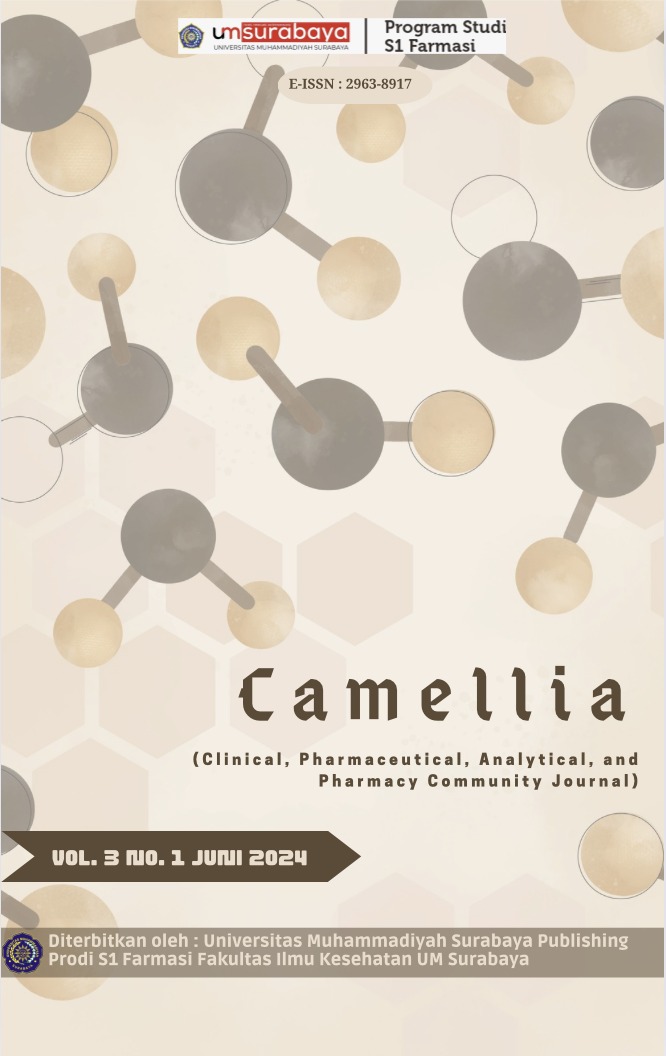The Physicochemical properties and in silico binding interaction with gyrase B of antibacterial compounds from aquous extract of Hibiscus sabdariffa L.
Abstrak
Hibiscus sabdariffa L. (Hs) is recognized to have various pharmacological activities such as antibacterial, antiedema, anti-fungal, antihypertensive, anti-inflammatory, and antiviral. The aquous extract of Hs’ calyx which is rich in polyphenols and flavonoids displayed antibacterial activity against several bacteria so that the compounds are important to be developed further as antibacterial agents. This study aims to find out which compounds contained in the extract have the antibacterial potency based on in silico interaction with gyrase B. Physicochemical descriptors of ten compounds were evaluated before molecular docking study, and the docking simulation was executed with Autodocktools 1.5.6. The selected compounds based on Lipinski’s Rules and their lower DG0 were subjected to prediction of pharmacokinetic and toxicity (ADMET) using pKCSM online tool. The results gave five test compounds showed the higher binding affinity on gyrase B compared to quercetin which served as inhibitor of the enzyme. The glycosides displayed better scores due to the existence of more hydroxyl groups. The potential aglycones were myricetin and delphinidin. According to the ADMET parameters, the two compounds have the best profile where they were neither hepatotoxic nor carcinogenic and also safer due to the higher LD50. In conclusion, the myricetin and delphinidin generated better binding interaction than the ligand inhibitor of gyrase B which indicated that they have higher potential as antibacterial agents.
Artikel teks lengkap
Referensi
Barancokova , M., Kikelj, D. & Ilas, J., 2018. Recent progress in the discovery and development of DNA gyrase B inhibitors. Future Medicinal Chemistry.
Campbell, M. K. & Farrell, S. O., 2009. Biochemistry. 6 penyunt. Belmont: Thomson Higher Education.
Cushnie, T. T. & Lamb, A. J., 2005. Antimicrobial activity of flavonoids. International Journal of Antimicrobial Agents, 26(5), pp. 343-356.
Da-Costa-Rocha, I. et al., 2014. Hibiscus sabdariffa L. – A phytochemical and pharmacological review. Food Chemistry, Volume 165, pp. 424-443.
de Brito, M. A., 2011. Pharmacokinetic Study with Computational Tools in the Medicinal Chemistry Course. Brazilian Journal of Pharmaceutical Sciencer, 47(4), pp. 797-805.
Dinata, D. I., Rendrika, R. & Kustida, Y. N., 2014. Pengaruh Aktivitas Senyawa Flavonoid Yang Terdapat Dalam Madu Terhadap Reseptor H4R Sebagai Antiinflamasi. Jurnal Farmasi Galenika , 01(02), pp. 61-70.
Fang, Y. et al., 2016. 3D-QSAR and docking studies of flavonoids as potent Escherichia coli inhibitors. Scientific Reports, Volume 6, pp. 1-13.
Herranz-Lopez, M. et al., 2012. Synergism of plant-derived polyphenols in adipogenesis: Perspectives and implications. Phytomedicine, Volume 19, pp. 253-261.
Higginbotham, K. L. et al., 2014. Aqueous Extracts of Hibiscus sabdariffa Calyces as an Antimicrobial Rinse on Hot Dogs Against Listeria Monocytogenes and Methicillin-resistant Staphylococcus aureus. Journal of Food Control , Volume 40, pp. 274-277.
Isnaeni, I., Hendradi, E. & Zettira, N. Z., 2020. Inhibitory Effect of Roselle Aqueous Extracts-HPMC 6000 Gel on the Growth of Staphylococcus Aureus ATCC 25923. Turk J. Pharm Science, 17(2), pp. 190-196.
Lipinski, C. A., Lombardo, F., Dominy, B. W. & Feener, P. J., 2001. Experimental and Computational Approaches to Estimate Solubility and Permeability in Drug Discovery and Development Settings. Advanced Drug Delivery Reviews, Volume 46, pp. 3-26.
Li, S. et al., 2005. IV-IVC Considerations in the Development of Immediate-Release Oral Dosage Form. Journal of Pharmaceutical Sciences, 94(7), pp. 1396-1417.
Palczar, J. M. & Chan, E., 1988. Dasar-dasar Mikrobiologi 2. Jakarta: Penerbit UI Press..
Pires, D. E. V., Blundell, T. L. & Ascher, D. B., 2015. pKCSM: Predicting Small-Molecule Pharmacokinetic ann Toxicity Properties Using Graph-Based Signatures. Journal of Medicinal Chemistry , Volume 58, pp. 4066-4072.
Plaper, A. et al., 2003. Characterization of quercetin binding site on DNA gyrase. Biochemical and Biophysical Research Communications, Volume 306, pp. 530-536.
Praja, R. A., Pratiwi, D. & N., 2018. Studi Penambatan Molekuler Senyawa Scopoletin dari Buah Mengkudu (Morinda Citrifolia L.) Pada Enzim ACE Sebagai Antihipetensi. Farmagazine, V(1), pp. 40-47.
Ramirez-Rodrigues, M. M. et al., 2011. Physicochemical and Phytochemical Properties of Cold and Hot Water Extraction from Hibiscus sabdariffa. Journal of Food Science, 76(3), pp. 428-435.
Ratnadi , P. C. & Sujana, I. B. G., 2017. Prinsip Dasar Farmakologi. Denpasar : Rumah Sakit Umum Pusat (RSUP) Sanglah Denpasar.
Ross, I. A., 2003. Medical Plants of The World. 1 penyunt. Totowa, New Jersey: Humana Press Inc.
Sorkun , M. C., Khetan, A. & Er, S., 2019. AqSolDB, a Curated Reference Set of Aqueous Solubility and 2D Descriptors for a Diverse Set of Compounds. Scientific Data, 6(143).
Syahputra, G., Ambarsari, L. & Sumaryada , T., 2014. Simulasi Docking Kurkumin Enol, Bismetoksikurkumin dan Analognya Sebagai Inhibtor Enzim 12-Lipoksigenase. Jurnal Biofisika , 10(1), pp. 55-67.
Vargas, F. M. et al., 2009. Development of a General Method for Modeling Asphaltene Stability. Energy and Fuels , Volume 23, pp. 1147-1154.
Veber, D. F. et al., 2002. Molecular Properties That Influence the Oral Bioavailability of Drug Candidates. Journal of Medicinal Chemistry , 45(12), pp. 2615-2623.
Penulis
Hak Cipta (c) 2024 Nuzul Wahyuning Diyah, Khairunnisa Andini, Isnaeni

Artikel ini berlisensiCreative Commons Attribution-ShareAlike 4.0 International License.
Penulis tetap memegang hak atas karyanya dan memberikan hak publikasi pertama kepada jurnal ini yang secara simultan karya tersebut dilisensikan di bawah: Creative Commons Attribution-ShareAlike 4.0 International (CC BY-SA 4.0)

